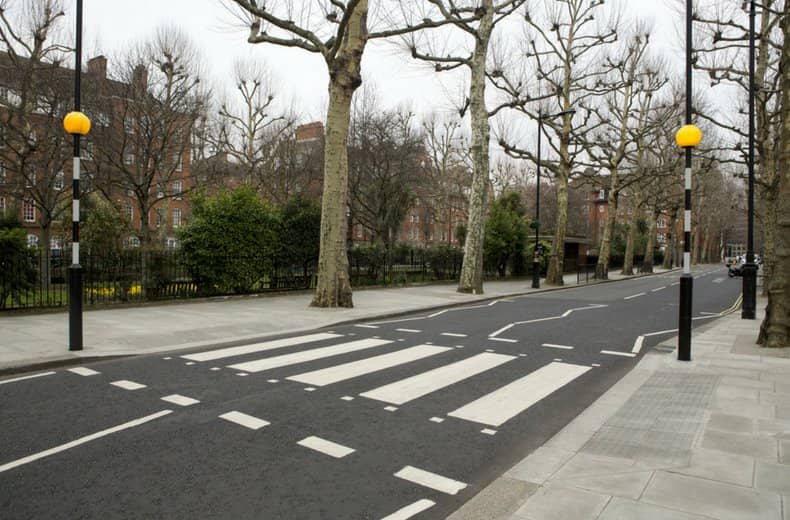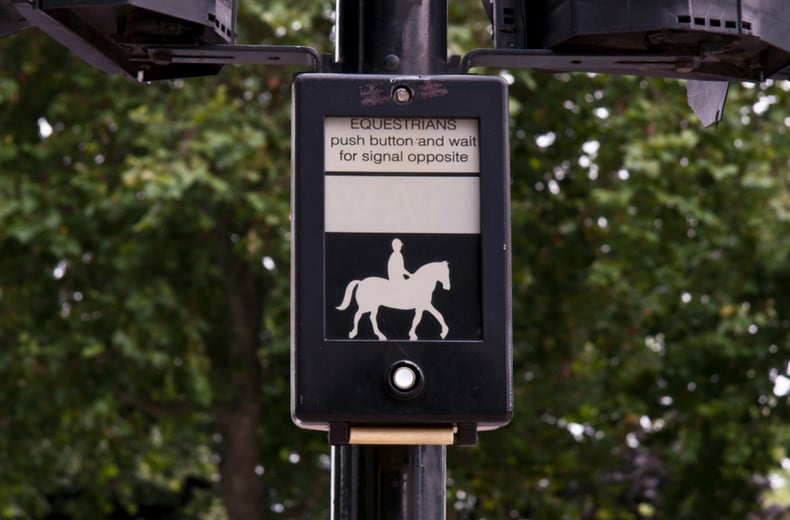Understanding the difference between zebra, pelican and puffin crossings is especially important for drivers who are learning to drive as they will need to demonstrate this knowledge to pass the theory driving test.
In this guide, we take a look at the main types of road crossing in the UK and point out their distinguishing features so you can understand the key differences between them.
What is a pelican crossing?

The pelican crossing is a common sight on UK roads. It has a button on each side of the road that pedestrians press when they want to cross the road. The button activates the traffic light sequence, which brings traffic to a halt and allows pedestrians to safely cross the road.
The pelican crossing - also known as a pedestrian light-controlled crossing– was introduced in Britain in 1969. It was the first light-controlled crossing in the UK to be operated by pedestrians and controlled by traffic lights.
How to spot a pelican crossing
As you approach a pelican crossing you’ll see a set of traffic lights with sets of zig-zag lines before and after on either side of the road.
A box with a display and a button will be on each side of the crossing.
How does a pelican crossing work?
A pelican crossing is activated when a pedestrian pushes the button on the control panel – these are found on traffic lights on both sides of the road.
Pressing the button prompts the traffic lights to switch to red. The ‘red man’ signal for pedestrians – found on the opposite side of the road to where they are standing – will turn to a ‘green man’, letting the pedestrian know it is safe to cross.
Where a pelican crossing goes straight across the road – even if there is a central refuge island – by law, motorists must wait for pedestrians to have finished crossing and for the light to be either flashing amber or green before proceeding.
If a crossing is staggered – with two different sets of traffic lights and a pedestrian refuge area in the middle – the crossings are treated as separate.
While in use, the ‘green man’ signal may begin to flash – this tells pedestrians not to start crossing but lets them know they can continue to do so if they’re already moving across the road.
A pelican crossing is the only crossing which has a flashing amber light as part of its sequence. If you see a flashing amber on the traffic lights while at a pelican crossing, it is signalling to the stopped traffic that they must give way to pedestrians already crossing. If the crossing is clear they may start driving.
Learner Driver Car Insurance
Only pay for the cover you need until you’ve passed your test. Get learner driver insurance so you can practice outside of your lessons.


What is a puffin crossing?

A puffin crossing is a traffic light controlled road crossing system that allows pedestrians to cross the road by pressing a button at the roadside.
Similar to a pelican crossing, a puffin crossing will have a ‘green man’ and ‘red man’ light system on the same side of the road to the user waiting to cross.
Unlike pelican crossings, puffins have a sensor that detects when the pedestrian has finished crossing the road.
How to spot a puffin crossing
A puffin crossing has a set of traffic lights with sets of zig-zag lines before and after on either side of the road.
How does a puffin crossing work?
Puffin crossings have two sensors on top of the traffic lights – a pedestrian crossing detector (PCD) and pedestrian kerb detector (PKD).
These make the crossing more efficient and safer by detecting whether pedestrians are crossing – which prompts the crossing to hold the red traffic light longer is someone is crossing slowly.
If the pedestrian presses the control panel and crosses prematurely or walks off – the sensors will cancel the request, preventing any hold of up traffic.
- 16 Highway Code rules most people ignore
- Did you know that we offer specialist learner driver insurance?
- How to pass your driving test - a full guide from novice to pro
There’s no ‘flashing’ phase as seen on traditional pelican crossings.
Having the pedestrian signal on the same side of the road to the crosser helps them to monitor traffic and also helps the visually-impaired who may struggle to spot the lights from further away.
Some puffin crossings are also fitted with small rotating handles which tell pedestrians with poor sight when to begin to cross.
What is a zebra crossing?

A zebra crossing is a black and white walkway with two orange lights, which span the width of the road. It is designed to allow pedestrians to cross the road, without the need for traffic lights.
Drivers must stop if someone crosses the road using a zebra crossing.
How to spot a zebra crossing
A zebra crossing is recognisable thanks to its black and white stripes on the road. You can also tell a zebra crossing as there will be zig-zag lines on either side of the road.
You may also be able to spot flashing amber globes on black and white posts – known as Belisha beacons – on each side.
How does a zebra crossing work?
Zebra crossings have no light traffic signal to control traffic flow – the right of way is automatically given to pedestrians.
If the crossing is split with a pedestrian refuge in the middle – they should be treated as two separate crossings.
Drivers should always make sure there are no pedestrians waiting to cross as they approach – taking care to check both sides of the road and ensure they have finished crossing safely before proceeding.
What is a toucan crossing?

The toucan crossing is similar to the traditional pelican crossing, but has one major difference - it allows cyclists to cross, too.
How to spot a toucan crossing
The toucan crossing look just like a pelican and puffin crossing from a distance – but the difference between a toucan crossing and a pelican or puffin crossing is that they have an additional signal for bikes.
Toucan crossings are usually found on the outskirts of parks or cycle lanes and are wider - around four metres - compared to pelican and puffin crossings which are around two metres wide.
How does a toucan crossing work?
To operate a toucan crossing, cyclists and pedestrians should press the control panel and wait for either the ‘green man’ signal or the ‘green bike’ signal to show.
Toucan crossings don’t have a flashing stage as part of their signal sequence.
- Roundabouts - how to deal with them and pass your test
- The Highway Code - common UK road signs and what they mean
- How to teach a learner driver - a guide to supervising a friend or family member

Cheaper than AA or we’ll beat by 20%^
• Roadside cover from £5.49 a month*
• We get to most breakdowns in 60 mins or less
• Our patrols fix 4/5 breakdowns on the spot

What is a pegasus crossing?

Pegasus crossings are the least common type of crossing found on UK roads. They bare similarities to toucan crossings but feature a higher-placed control for horse riders to press without dismounting. They also feature a control panel at normal height for pedestrians to operate.
How to spot a pegasus crossing
Pegasus crossings are commonly found near parks and areas popular with riders. They’ll usually have additional safety features such as fences or barriers nearby. They are also usually wider than pedestrian-only crossings to keep vehicles further away from horses.
How to does a pegasus crossing work?
A pegasus is operated in the same way as a pedestrian-only crossing.
Like puffin crossings, they can also detect when there is movement on the road and hold the signal longer to allow horses and their riders to cross safely.
Pegasus crossings also don’t have a flashing stage, they switch between green and red only.
What is a school crossing?

School crossings are operated by a lollipop person or a school crossing patrol officer, and are vital to children’s safety as they make their way to and from school.
Under the Road Traffic Regulation Act 1984 it is a criminal offence not to stop when a crossing guard signals for you to do so.
How to spot a school crossing
As you approach the crossing there will usually be a flashing amber signal to alert drivers to the possibility of pedestrians in the road ahead.
This will be accompanied by road signs signalling that school children may be crossing.
How does a school crossing work?
A soon as the crossing guard steps into the road, motorists must stop and should not proceed until all pedestrians are safely across and back on the pavement.
Failure to follow these rules could result in a £1,000 fine, three penalty points or even driving disqualification.
If you are using a school crossing, make sure you do not cross until told it is safe to do so and never walk behind the crossing guard.
Cyclists should always dismount before using the crossing.
Safety is obviously paramount when driving on the roads and with RAC Black Box insurance you’ll be rewarded for driving safely.
The black box fitted in your vehicle monitors things like breaking (for example as you approach a pedestrian crossing). On renewal your premium will be calculated using this data. You could benefit if you’ve got what are deemed to be safe driving habits.

Cheaper than AA or we’ll beat by 20%^
• Roadside cover from £5.49 a month*
• We get to most breakdowns in 60 mins or less
• Our patrols fix 4/5 breakdowns on the spot













